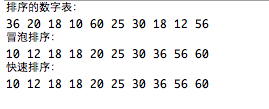[Java]交换排序
2015-05-29 21:09
316 查看
交换排序的基本思想:通过排序表中两个记录关键码的比较,若与排序要求相逆,则将二者进行交换,直至没有反序的记录为止。交换排序的特点是:排序码值较小的记录向序列的一端移动,排序码值较大的记录向序列的另一端移动。
,对n个记录的排序表进行冒泡排序(Bubble Sort)的过程是:第一趟,从第一个记录开始到第n个记录,对n-1对相邻的两个记录关键字进行比较,若与排序要求相逆,则将二者交换,这样,一趟过后,具有最大关键字的记录交换到R
;第2趟,从第1个记录开始到第n-1个记录继续进行第二趟冒泡,两趟过后,具有次最大关键字的记录交换到了R[n-1]……如此重复。n-1趟过后,在R[1]….R
中,n个记录按关键字码有序。
Java代码(可直接使用):

1、冒泡排序
设排序表为R[1]….R,对n个记录的排序表进行冒泡排序(Bubble Sort)的过程是:第一趟,从第一个记录开始到第n个记录,对n-1对相邻的两个记录关键字进行比较,若与排序要求相逆,则将二者交换,这样,一趟过后,具有最大关键字的记录交换到R
;第2趟,从第1个记录开始到第n-1个记录继续进行第二趟冒泡,两趟过后,具有次最大关键字的记录交换到了R[n-1]……如此重复。n-1趟过后,在R[1]….R
中,n个记录按关键字码有序。
2、快速排序
快速排序的核心操作是划分。以某个记录为标准(也称为支点),通过划分将待排序列分成两组,其中一组中的记录的关键码均大于或等于支点记录的关键码,另一组中的所有记录的关键码小于支点记录的关键码,则支点记录就放在两组之间,这也是该记录最终位置。Java代码(可直接使用):
public class SwapSort {
public static void main(String[] args)
{
int number1[] = {36,20,18,10,60,25,30,18,12,56};
System.out.println("排序的数字表:");
for(int i=0;i<number1.length;i++)
{
System.out.print(number1[i]);
System.out.print(" ");
}
/*--------------冒泡排序---------------*/
BubbleSort(number1);
System.out.println("\n冒泡排序:");
for(int i=0;i<number1.length;i++)
{
System.out.print(number1[i]);
System.out.print(" ");
}
int number2[] = {36,20,18,10,60,25,30,18,12,56};
/*--------------快速排序---------------*/
QuickSort(number2,0,number2.length-1);
System.out.println("\n快速排序:");
for(int i=0;i<number2.length;i++)
{
System.out.print(number2[i]);
System.out.print(" ");
}
}
//快速排序
public static void QuickSort(int[]R,int s,int t)
{
int i;
if(s<t)
{
i=Partition(R,s,t);
QuickSort(R,s,i-1);
QuickSort(R,i+1,t);
}
}
//划分算法
public static int Partition(int[] R,int low,int high)
{
int c;
c=R[low];
while(low<high)
{
while(low<high&&R[high]>=c)
{
high--;
}
if(low<high)
{
R[low]=R[high];
low++;
}
while(low<high&&R[low]<c)
{
low++;
}
if(low<high)
{
R[high]=R[low];
high--;
}
}
R[low]=c;
return low;
}
//冒泡排序
//空间复杂度O(1);时间复杂度O(n^2);
public static void BubbleSort(int[] R)
{
int i,j,c,swap;
for(i=1;i<R.length;i++)
{
swap=0;
for(j=0;j<R.length-i;j++)
{
if(R[j]>R[j+1])
{
c=R[j];
R[j]=R[j+1];
R[j+1]=c;
swap=1;
}
}
if(swap==0)
{
break;
}
}
}
}
相关文章推荐
- JavaScript演示排序算法
- 算法之排序算法的算法思想和使用场景总结
- php 地区分类排序算法
- js三种排序算法分享
- Javascript中的常见排序算法
- java 合并排序算法、冒泡排序算法、选择排序算法、插入排序算法、快速排序算法的描述
- 排序算法的javascript实现与讲解(99js手记)
- C++中十种内部排序算法的比较分析
- Java实现几种常见排序算法代码
- 浅谈javascript实现八大排序
- JavaScript中九种常用排序算法
- STl中的排序算法详细解析
- PHP四种基本排序算法示例
- 排序算法之PHP版快速排序、冒泡排序
- JavaScript排序算法之希尔排序的2个实例
- Java常用排序算法及性能测试集合
- Java中常用的6种排序算法详细分解
- Javascript排序算法之合并排序(归并排序)的2个例子
- JAVA简单选择排序算法原理及实现
- 通用动态数组(三)——算法排序
